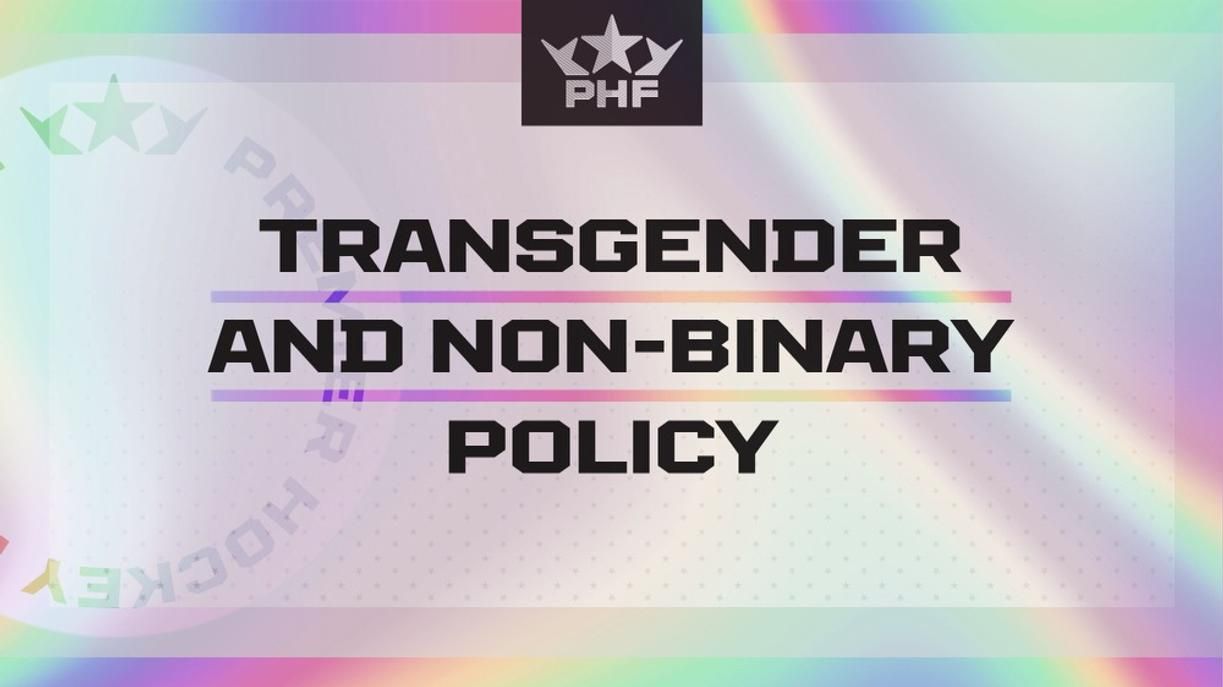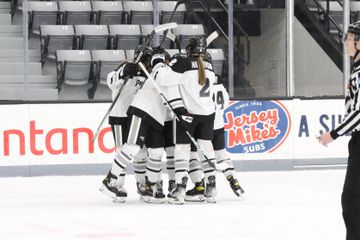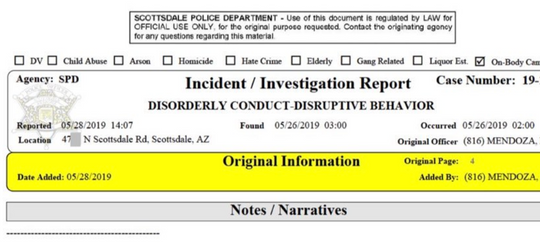The world I envision for trans and nonbinary athletes is one that is very different from the reality that cis gatekeepers create. Even the most inclusive policy cannot withstand the pressures of being created, implemented, and enforced by cis management. When that management has a dubious track record of inclusion, and a documented history of transphobic behavior and rhetoric, it is hard to see how even the most robust and progressive policy can serve the purpose for which it was ostensibly created.
The new PHF Transgender and Non-binary Player Inclusion Policy is the league's second attempt at providing a policy to include trans and nonbinary players, and the policy announcement has come as the Premier Hockey Federation is going through its own transition of sorts. Its recent rebranding, from the National Women's Hockey League to the PHF, was at least in part an attempt to acknowledge the trans and nonbinary players who call the league home, according to the league's own messaging. The rebranding is emblematic of a tension that has been plaguing the organization in 2021: employing progressive and inclusive messaging while acting in a way that undermines those words. The Lake Placid season featured obvious examples of racism and white supremacy, extremely belated condemnation of that racism and white supremacy, and at best a casual concern for player safety leading to many players and staff becoming infected with COVID-19.
Earlier this month, in an excellent interview conducted by D.F. Pendrys, Toronto Six president Digit Murphy and team owner Johanna Boynton tried to employ progressive language when discussing trans issues but floundered miserably. Murphy, who was not disciplined by the league or the team owner for her support of the Women's Sports Policy Working Group, has refused accountability for her actions, choosing at every turn to use ignorance as a defense. Credit to Pendrys for their persistent questioning, but Murphy's equivocations on her role with the WSPWG and trans inclusion, when taken with her lack of awareness about the PHF's policies, undermine any progressive message the pair might have been trying to illustrate.
This is not to rehash past (if recent) failures but to illustrate the context for the October 15 new policy reveal. Anecdotally, it's a policy that seems to have struck the right notes, judging from initial reactions, and some of that approval is because it's a document that can be used to show progress on trans and nonbinary inclusion. For many cis people, incremental progress, no matter how slight, is enough to satiate calls for change.
There are several big positives. The PHF's press release emphasized that this policy was developed in consultation with Athlete Ally. Athlete Ally is an LGBTQ2IA ally organization (founded and run by a cis, straight man, Hudson Taylor) that works with athletes, teams, and governing bodies to achieve queer inclusion in all levels of sport. The league named two people who consulted with them on the policy: Anne Lieberman, Athlete Ally's Director of Policy and Programs; and Chris Mosier, a trans man and triathlete, former VP with You Can Play, and founder of transathlete.com. The federation specifically emphasized Mosier's participation on social media and in the release itself. The PHF should absolutely be consulting with outside organizations on such policies, not just because of its dubious recent record on trans inclusion, but also because such policies should always seek outside, expert opinions.
However, it is not clear from this announcement whether any trans women were included as part of Athlete Ally's consultation and to not consult with trans women or to not make that consultation abundantly clear is a massive mistake. The policy has several elements that are specific to trans women. When asked for comment regarding whether trans women were part of the policy process, a PHF representative did not respond to that query.
Outside opinion alone does not necessarily result in truly substantive material change. The NWHL also consulted with people outside of the organization on its original policy (including Chris Mosier). That they've done so again and once again produced a problematic policy suggests just as much about those the federation consults with as it does the PHF. The effectiveness of consultation is limited by the willingness of those in power to implement recommendations. It is impossible to know what recommendations from the Athlete Ally team, Lieberman, and Mosier made the final version of the policy and what advice was left out of the document.
These policy changes illustrate why queer ally organizations in elite sports can ultimately fail the queer people they wish to advocate for. Ally organizations often operate within the existing framework of elite sports, sliding into an assimilationist role that prioritizes increased participation on the part of marginalized athletes rather than a dramatic restructuring of the binary and inherently discriminatory sports hierarchy. The end result is that marginalized people, like trans and nonbinary folks, have more avenues into playing elite sport, which is great – but they end up doing so in a system designed by and for cis people that has to create special policy to include some (but not all) of them, rather than being designed to include them at the base level.
The PHF policy does make considerable strides when compared with the previous NWHL policy it replaced. As I wrote at the time of its release, the NWHL's policy was centered on hormone levels to the detriment of the trans and nonbinary athletes it was alleged to include. The PHF policy does not subject trans women and nonbinary athletes to arbitrary, subjective, and discriminatory hormone level requirements and this is a significant improvement when compared with other similar policies, such as the NWSL's version. The PHF policy also makes provisions for trans men and nonbinary players who wish to undergo hormone therapy to continue to play. This is a welcome change that could see more trans men and nonbinary athletes continue their playing careers, which was not the case with the previous policy. These are legitimate positive developments that move the policy in the right direction when it comes to including trans and nonbinary athletes.
Unfortunately, the policy also has several questionable aspects. While the league has removed subjective testosterone level restriction for trans women and nonbinary people, it has been replaced with additional arbitrary eligibility factors. Affected athletes can only participate "if they have been living in their transgender identity for a minimum of two years." While it is common for such policies to have a waiting period (a convention I do not personally agree with), the PHF's period is a year longer than most comparable policies. What defines the awkwardly phrased "living in their transgender identity" requirement is not clear from the policy. It does not specify who will make this determination of validity for trans women, but the policy does note that the PHF will make this determination for nonbinary players. Its lack of specificity is probably, to some degree, by design. But it creates significant opportunity for discrimination. Trans and nonbinary identity is multifaceted, infinitely diverse, and can change over time.
These specific restrictions for trans women and nonbinary players are arbitrary, poorly defined, and serve to disrupt and stall the already limited time-period athletes have for their careers. It also emphasizes the binary nature of this policy. The title of the regulations and the way the league promotes it suggests that PHF has done the necessary work to right the wrongs of the previous policy which erased nonbinary athletes. But to divide trans and nonbinary athletes from each other in such distinct ways demonstrates how cis and binary this policy remains in its conception.
At the heart of these specific requirements is the refusal to see trans women as women, denial that nonbinary people deserve opportunities to play at the highest level, and a bioessentialist fear of the dangerous male body and conviction in female frailty. The league confirmed as much in a statement to Pendrys. It is hard to envision a policy that can truly support and enrich the lives of trans women and nonbinary athletes that includes the kind of fearmongering that endangers so many transfeminine people. It is policy language carefully designed to be palatable to cis folks with a cursory concern about progressive language.
The time period established in removing medicalized requirements and mandatory disclosure is to safeguard against the potential concern that someone would attempt to assert an identity that is not truly held." - End of PHF Statement 5/5
— D.F. Pendrys...The Uh...Vampire (@dfpendrys) October 18, 2021
The PHF's insistence on therapeutic use exemptions (TUE) for trans men and nonbinary people using T as part of their transition or as part of their ongoing health care might seem reasonable, but in practice, it seems to call out transmasculine people unnecessarily. The PHF does not have a known anti-doping policy nor do they conduct regular anti-doping testing. TUEs are used in sports that conduct regular anti-doping testing, and the point of obtaining a TUE is so that the samples from athletes with medical exemptions aren't constantly flagged. In a league that does not follow a regular anti-doping testing regime, it makes little sense to require TUE for trans and nonbinary athletes. If you do not have a testing regime, you can just allow testosterone for trans and nonbinary athletes for use as part of gender affirming care, and not frame it as a required exemption.
So, what does this requirement achieve? The point of this TUE seems to be more about assessing the validity of the request:
Transgender men are eligible to compete in the PHF, but if they are taking testosterone for transition-related purposes, such use must be pursuant to a therapeutic use exemption as determined by the PHF, in consultation with the athlete's physicians and applicable medical experts…
A non-binary athlete assigned female at birth who is taking testosterone for transition-related purposes is eligible to compete in the PHF, but such use must be pursuant to a therapeutic use exemption as determined by the PHF in consultation with the athlete's physicians and applicable medical experts.
But this isn't a policy that centers gender diverse perspectives. Ultimately it's a policy that improves conditions for trans and nonbinary athletes to a degree while maintaining enough distinctions, regulations, and conditions to appease cis gatekeepers.
Again, as the regulations are written, I'm left wondering what criteria the league will use to make these determinations. One can assume that Lisa Haley, SVP of Hockey Operations, will be involved. Haley is specifically named in section 15.4 as the league point-person for players who wish to come out and presumably takes part in the "determination" stage regarding whether a trans or nonbinary athlete is eligible to compete. I have concerns about this as Haley worked as part of Murphy's coaching staff last season and did not comment on Murphy's association with the WSPWG nor her support of their policies. This is not to brush Haley as transphobic by association, merely to highlight that someone who will play a key role in the public coming out process for trans and nonbinary players failed to advocate for LGBTQ2IA players in a key moment. As a trans person, I want someone who advocates for trans and nonbinary people publicly, wholeheartedly, and without hesitation to be in charge of this process.
There are several positive changes in the updated PHF trans and nonbinary inclusion policy, and these changes should help more gender diverse folks continue their hockey careers in a competitive league. But it is still a policy implemented by cis gatekeepers. Until cis leaders and players are willing to surrender this policymaking power to trans and nonbinary people, these policies will remain flawed. If you're a trans and nonbinary player, the story remains the same. You can play, but you have to play by our rules.
The Victory Press sent the following questions to the PHF:
- Does the PHF currently have a testing policy for PEDs for which a therapeutic use exemption would be required? If so, what is that PED testing policy and how is testing administered?
- Is there a current PHF rule book available that the public and media can refer to regarding all guidelines for player eligibility to see how the trans/non-binary player policy works in conjunction with general eligibility?
- How does the PHF define "coming out" in this context: "If an athlete who is currently playing in the PHF wants to come out as [transgender or nonbinary] they are able to do so." Does this mean that an active player is able to "come out" as a different gender identity AND maintain PHF eligibility? Would it not be simpler to just state that anyone of any gender identity, other than cisgender men, is eligible to play in the PHF?
- Were trans women consulted in the formation of this policy?
- What is the purpose of the two year waiting period for trans women?
- What is the criteria or process used by the PHF to determine if someone is "living in their identity"? What is the process framework to be used by Lisa Haley once she hears from a player wishing to "come out" as a different gender identity or participate in the PHF under the guidance of this policy?
- Would the PHF expect a player who is afab or intersex to "come out" to the PHF if they are not undergoing any hormone therapies that would require a TUE?
- Regarding this language under 15.6.6:
"Accept all in the gender they present; verification of their identity should be no more than expected of any other person"
What is the verification of identity that would be expected of "any other person" referred to here? - Is this policy meant to be considered inclusive of intersex individuals as well?
In response, the PHF sent the following statement:
Currently, the majority of policies governing the participation of transgender and non-binary athletes are focused on medical intervention and testosterone suppression specifically for transgender women. The PHF, with Athlete Ally and Chris Mosier, felt it was important to move away from medicalized language and mandatory disclosure, and instead to adopt an identity-based policy.
Our policy is the first to remove mandatory medical intervention for trans women at the professional level.
The time period established in removing medicalized requirements and mandatory disclosure is to safeguard against the potential concern that someone would attempt to assert an identity that is not truly held.
The new iteration of the policy is intended to support every athlete, not to find a loophole to exclude them. The PHF, in partnership with Athlete Ally and Chris Mosier, were very intentional about the core principles that guide the document in that respect.
Policies governing the participation of transgender athletes, non-binary athletes and athletes with intersex variations are often conflated. People with intersex variations are not a monolith, and having an intersex variation does not dictate one's gender identity. People with intersex variations are able to compete in the PHF in accordance with their gender identity and the policy outlined by the PHF for transgender and non-binary athletes.







